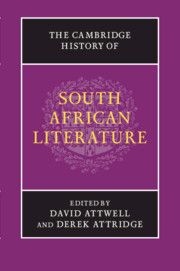Book contents
- Frontmatter
- Introduction
- PART I ORATURES, ORAL HISTORIES, ORIGINS
- PART II EXPLORATION, EARLY MODERNITY AND ENLIGHTENMENT AT THE CAPE, 1488–1820
- PART III EMPIRE, RESISTANCE AND NATIONAL BEGINNINGS, 1820–1910
- PART IV MODERNISM AND TRANSNATIONAL CULTURE, 1910–1948
- PART V APARTHEID AND ITS AFTERMATH, 1948 TO THE PRESENT
- 19 The fabulous fifties: short fiction in English
- 20 Writing in exile
- 21 Afrikaans literature, 1948–1976
- 22 Afrikaans literature after 1976: resistances and repositionings
- 23 The liberal tradition in fiction
- 24 Black Consciousness poetry: writing against apartheid
- 25 Popular forms and the United Democratic Front
- 26 Writing the prison
- 27 Theatre: regulation, resistance and recovery
- 28 The lyric poem during and after apartheid
- 29 Writing and publishing in African languages since 1948
- 30 Writing the interregnum: literature and the demise of apartheid
- 31 Rewriting the nation
- 32 Writing the city after apartheid
- PART VI SOUTH AFRICAN LITERATURE: CONTINUITIES AND CONTRASTS
- Index
- References
32 - Writing the city after apartheid
from PART V - APARTHEID AND ITS AFTERMATH, 1948 TO THE PRESENT
Published online by Cambridge University Press: 28 January 2012
- Frontmatter
- Introduction
- PART I ORATURES, ORAL HISTORIES, ORIGINS
- PART II EXPLORATION, EARLY MODERNITY AND ENLIGHTENMENT AT THE CAPE, 1488–1820
- PART III EMPIRE, RESISTANCE AND NATIONAL BEGINNINGS, 1820–1910
- PART IV MODERNISM AND TRANSNATIONAL CULTURE, 1910–1948
- PART V APARTHEID AND ITS AFTERMATH, 1948 TO THE PRESENT
- 19 The fabulous fifties: short fiction in English
- 20 Writing in exile
- 21 Afrikaans literature, 1948–1976
- 22 Afrikaans literature after 1976: resistances and repositionings
- 23 The liberal tradition in fiction
- 24 Black Consciousness poetry: writing against apartheid
- 25 Popular forms and the United Democratic Front
- 26 Writing the prison
- 27 Theatre: regulation, resistance and recovery
- 28 The lyric poem during and after apartheid
- 29 Writing and publishing in African languages since 1948
- 30 Writing the interregnum: literature and the demise of apartheid
- 31 Rewriting the nation
- 32 Writing the city after apartheid
- PART VI SOUTH AFRICAN LITERATURE: CONTINUITIES AND CONTRASTS
- Index
- References
Summary
Prior to the late 1980s, South African urban geography expressed the ambitions of apartheid ideologues: the identity of black South Africans was essentialised along a rural–urban axis (casting them as ‘temporary sojourners’ in ‘white’ cities), and zoning, forced removals, curfews, influx control generally and the dompas in particular were used to establish and entrench racial divisions in the cities. To the extent that urbanisation was permitted, it occurred in a uniquely constrained and regulated way: cities came to comprise a combination of dormitory (black) townships, (white) suburbs and industrial areas, all gathered around a central business district (CBD) which coordinated the flows of capital. Apartheid parochialism, economic sanctions and the cultural boycott made these cities increasingly anachronistic and disjunctive. They were shielded – by a formidable apartheid bureaucracy – from the political, economic and social realities of their African and global context.
These cities figure in South African literature centrally as destinations for migrant labourers. ‘Jim comes to Jo ‘burg’ is an organising trope of representations of black urban experience before and during apartheid. In this regard, novels such as R. R. R. Dhlomo's An African Tragedy (1928), an allegory of the corruption of its protagonist ‘Robert Zulu’, Alan Paton's Cry, the Beloved Country (1949) and F. A. Venter's Swart Pelgrim (1958), which won the Hertzog Prize in 1961, are paradigmatic. Each develops a version of the convention of the ‘greenhorn’: an uncorrupted black man arrives from a rural (‘traditional’) context and discovers a mesmerising but overwhelming Johannesburg.
- Type
- Chapter
- Information
- The Cambridge History of South African Literature , pp. 676 - 694Publisher: Cambridge University PressPrint publication year: 2012
References
- 8
- Cited by



